In this coaching piece, we will look at how you can develop your teams’ ability to create and exploit the opponent’s weak side. First, we will break it down in a tactical analysis of what is meant by a ‘weak-side’.
Secondly, with the support of a comprehensive analysis into the tactics used by the teams that get success through creating and exploiting the weak side, we can take an evidence-based approach into what can and will determine your ability to get success.
Finally, we give you a four-part training session that offers a logical progression from a technical and principle-based practice that develops into a tactical and realistic game practice.
What is the ‘weak-side’
Very simply, the weak-side refers to the side of the field the defending team has offered more space and fewer players to temporarily, such that they are compact and well organised to defend on the other side of the field.
In order to be horizontally compact to deny the attacking team any gaps to play passes through as well as to deny the attacking team numerical superiority in wide areas, the defensive team has to shift across to be compact to the side of the play. As a result, they will temporarily offer up space on the opposite side, the ‘weak-side’.
The famed’ weak-side’ is a problem area for many teams that have to defend against high-quality possession-based teams. Such teams like Manchester City, Liverpool FC and Real Madrid have all achieved a high degree of success this past season by unlocking a teams defence from a quick switch of play to the weak-side.
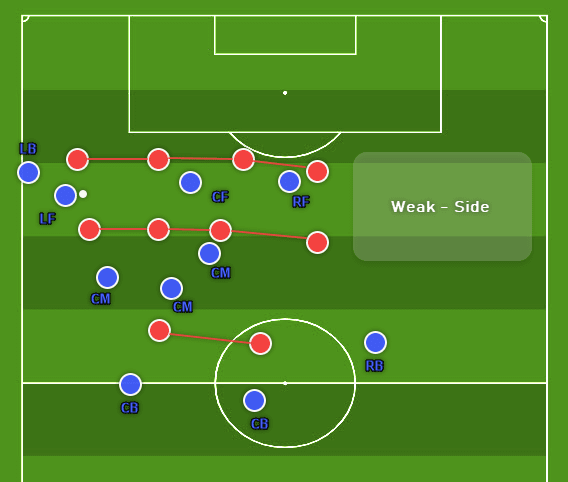
Above, is a tactical annotation to highlight the weak-side of a defensive team. We can easily identify the trade-off in having wider gaps between players horizontally that would stretch across to the weak-side. Three problem areas that arise for the defensive team are wider gaps for penetrating passes to come through. Secondly, the attacking team may play through the defence in wide areas by creating overloads. Third and finally, there is also more space for the attacking team to create and succeed in one-versus-ones.
How teams create and exploit the weak-side
Here is but one pattern we commonly see proficient possession-based attacking teams develop to exploit the weak-side. below, the attacking team at this moment has created a dangerous attack with an overlapping full-back supporting the attack on the left. As the defending team has shifted across to be compact, the blue team play an out-ball into midfield before the centre-midfielder plays an attacking pass to meet the run of the advancing right-back.
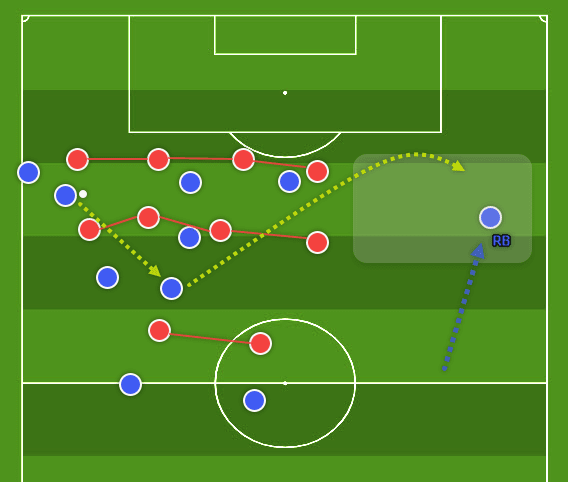
Often we see the defending team offer more players to the defensive unit to offer protection on the weak-side; however, it comes with a trade-off. It is not always deliberate as the midfielders on the defending team may follow their respective opposite number as he or she makes a run from deep; therefore, this midfielder automatically joins the defensive line.
Whether the manager sets his team out to defend with five or more players in the back-line or it happens by proxy of defending attacking runs. The danger is that the numerical inferiority in midfield and up-front allows the attacking team to retain easier and advance closer to the edge of the box where more opportunities open up.
Let’s take a look at some examples below.
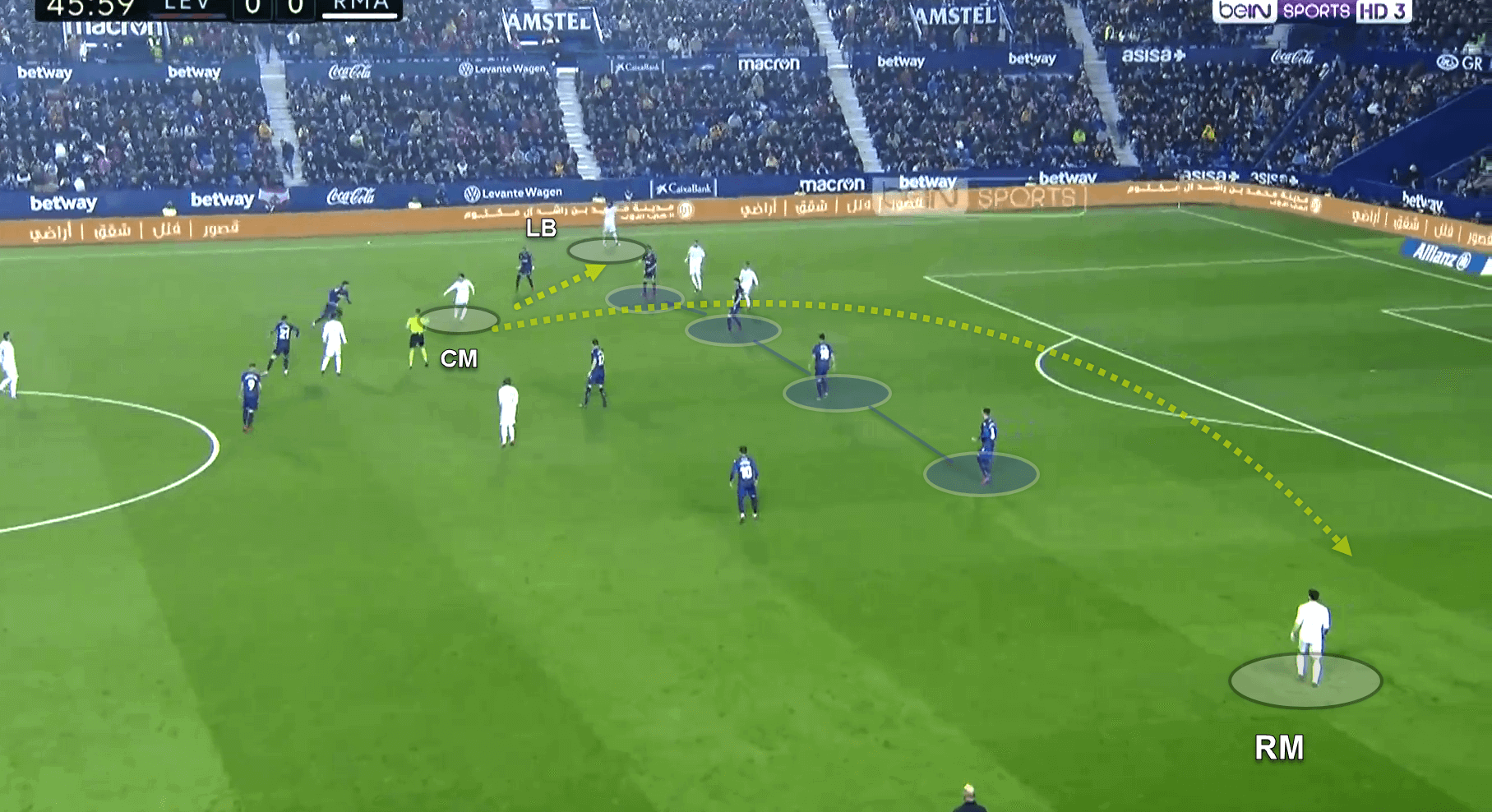
In the most recent meeting between Levante and Real Madrid in La Liga this past season we saw Real Madrid cause their opposition defensive chaos as they played a lot of long horizontal passes to the weak-side. At this moment, we see right-midfielder Lucas Vázquez hold his with for such long periods in anticipation he will receive a long attacking pass. A pass that will task him with advancing his team forward into a goal-scoring position. Notice the defensive shape Levante are forced to take up to be compact on their right side of the field.
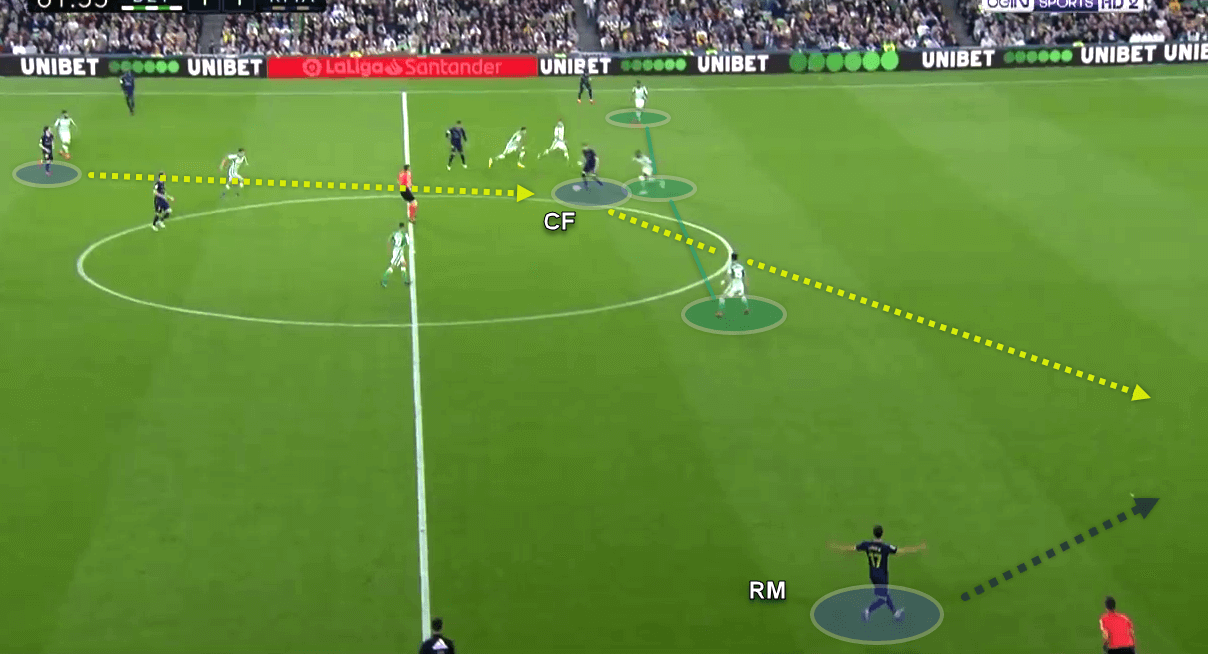
Again, above we see Vázquez hold the width on the right side of the field as he plays as high as he can to the offside line as he waits to start his run and meet the attacking pass of the centre-forward in possession, Karim Benzema. Observe also, at the top of the screen helping to hold Real Betis back-line to that side while helping to create space for Vázquez is Vinícius Júnior.
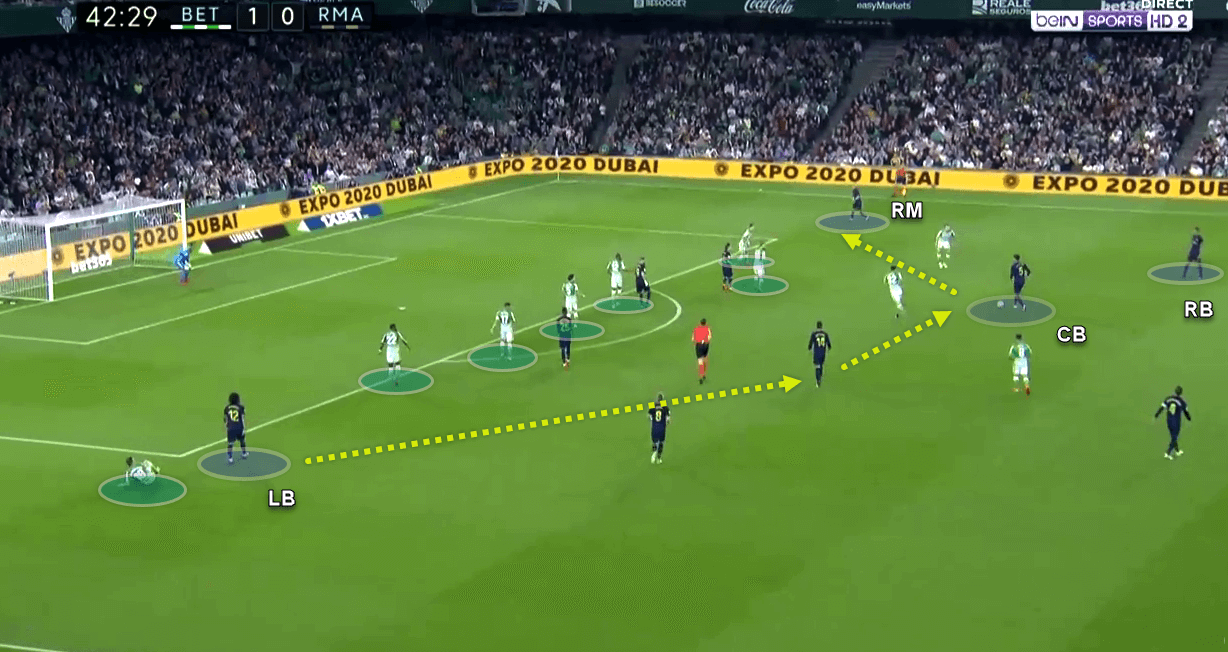
Above, we see another example of how through the good movement of attacking runs and the ability to keep possession Real Madrid force Real Betis into committing seven players into the back-line. Although this success will offer subsequent challenges to break down this unit, it has however forced Betis to relinquish their attacking threat as well as allowed Real Madrid to offer more players into the final third.
Committing both full-backs
Before we get into the training ground piece, there is one important aspect to look at for any coach looking to develop his or her teams’ ability to exploit the weak-side, and that is, committing both full-backs.
A lot of coaches still believe that there will be this natural orthodox rhythm of one full-back attacks while the other tucks-in, I’m afraid this seldom happens so well as planned. Consider, for a full-back to read that the pass is going to be made from the opposite side of the field to his or her side. By the time the pass is anticipated, he or she already needs to be an average of 40-yards higher up the field to be an effective attacking outlet.
If the full-backs are both high, commanding the wide areas of the field when in possession then there is perhaps more opportunity to attack and sometimes more opportunity to retain possession. In contrast to an overcautious full-back who is sitting too deep when play develops on his or her side.
Let’s take a look at some examples of Real Madrid committing both full-backs when exploiting the opponents’ weak side.

Above we see Real Madrid right-back is about to play a long diagonal pass to meet the run of the left-back Marcelo Vieira. Moments before the pass play had developed on the right for a considerable amount of time and with good rotations and movement in the wide areas. This caused Real Betis to shift across and offer the space that Marcelo would subsequently attack.

Again, we see in the same game, Toni Kroos the Madrid central-midfielder is about to play a long diagonal pass to meet the run of the right-back Dani Carvajal. After play had developed on the left side of the pitch for Madrid there was ample space and opportunity to penetrate the space offered on the opposite side of the field.
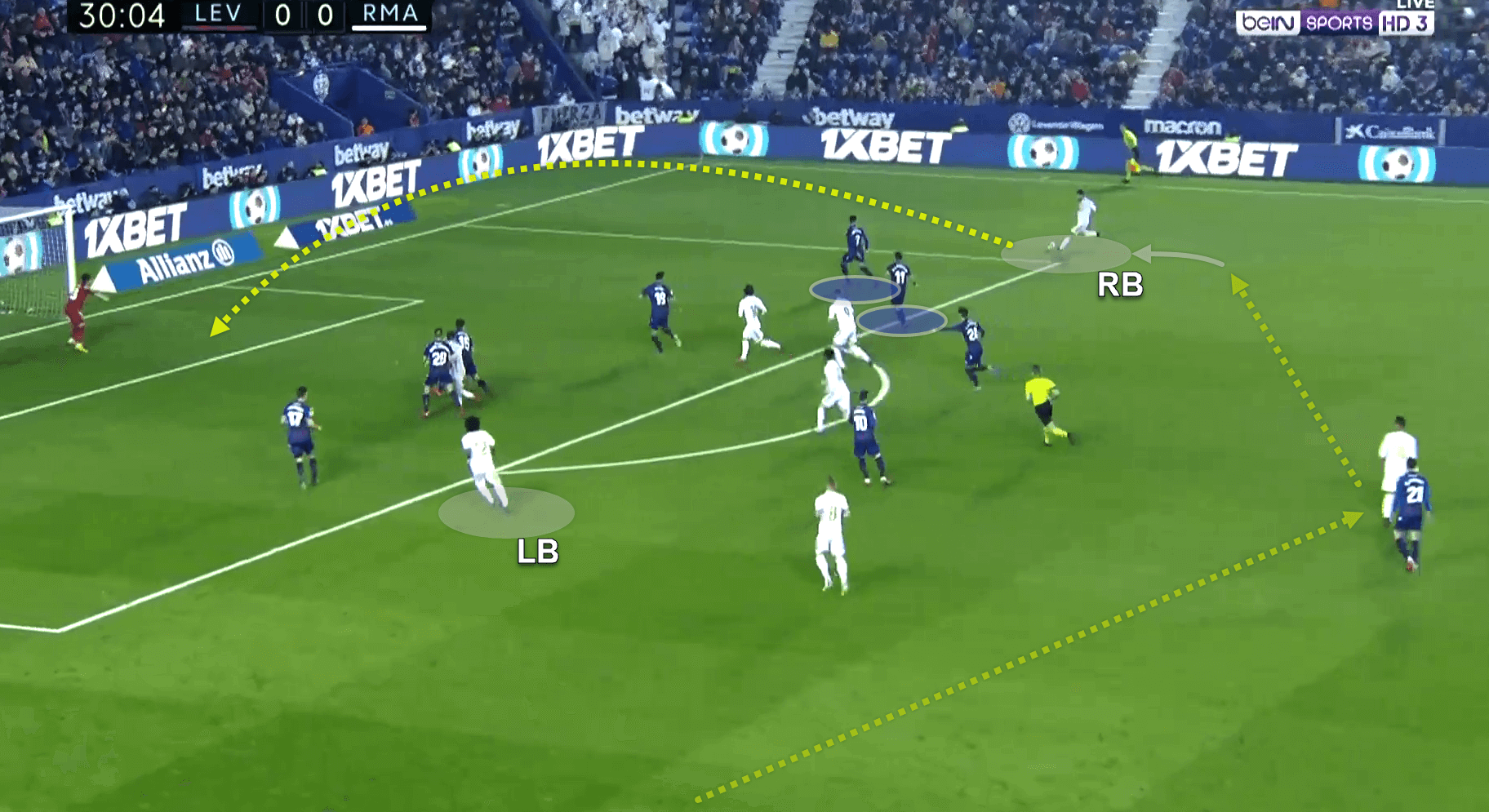
Above we see in the recent game between Levante and Madrid, both full-backs were integral to developing prominent attacks for their team. One advantage we can highlight now that is often overlooked is the attacking full-back who meets a pass on the weak-side has more time, space as well as a full range of angles to cross. In contrast, to a full-back who has to try and deliver a cross when the opposition are tight and denying him or her their desired angle for a cross.
Committing both full-backs should be food for thought to a coach who has not considered it previously. Such thoughts to consider are both the attacking potential as well as ramifications of not being as effective as desired.
The training ground
This session is designed to accommodate an 11-aside team, playing in either a 4-4-2 or a 4-3-3.
Depending on the ability and age of your players, you may want to make certain modifications such as area sizes as well as more robust or easier conditions.
Finally, the core aspects that these practices engage with in the players are the technical and tactical principles for identifying playing to the weak side. As for the complexity of different players arriving in different positions, with ever-changing distances of support and pressure, there are more sessions that can be developed around this area. Nonetheless, these practices serve to be very rich in detail and challenges that will improve the player and teams ability to exploit the weak side.
Practice #1: Developing the principles
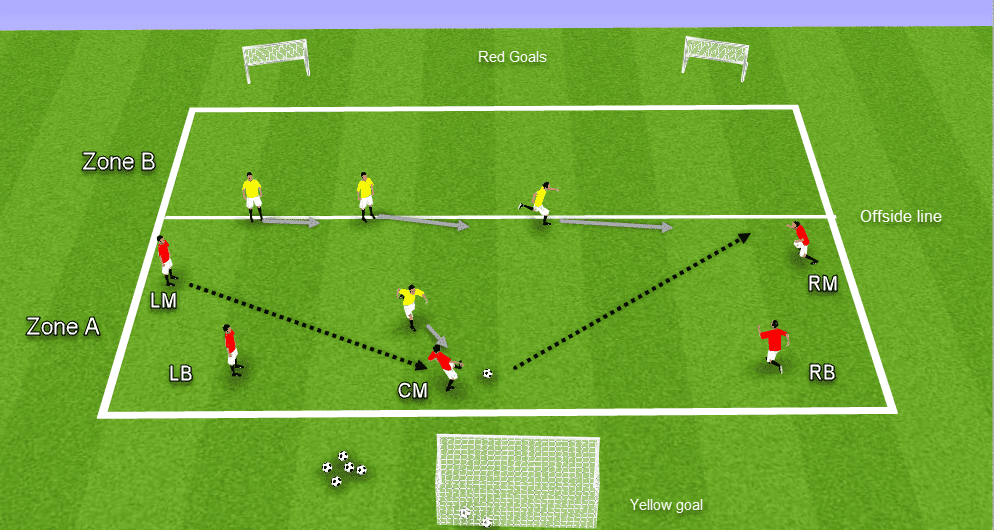
Organisation:
- 30 x 30m area
- Reds start play in zone ‘A’ and look to enter zone ‘B’ before scoring in either net
- Three yellows must stay and move horizontally on ‘offside line.’
- One yellow player can press in zone A or join defensive block.
- Reds must dribble over the offside line or pass into an on-side run to score
- If and when yellows win possession, they can score in the big goal at their earliest opportunity.
Coaching:
- Minimise stoppages to keep the tempo high
- Promote passing qualities and good speed of play
- Stretch the width to create a weak side
- Players should honour their natural positions
- Good horizontal play when necessary to unlock the defensive block
Practice #2: Game realistic practice
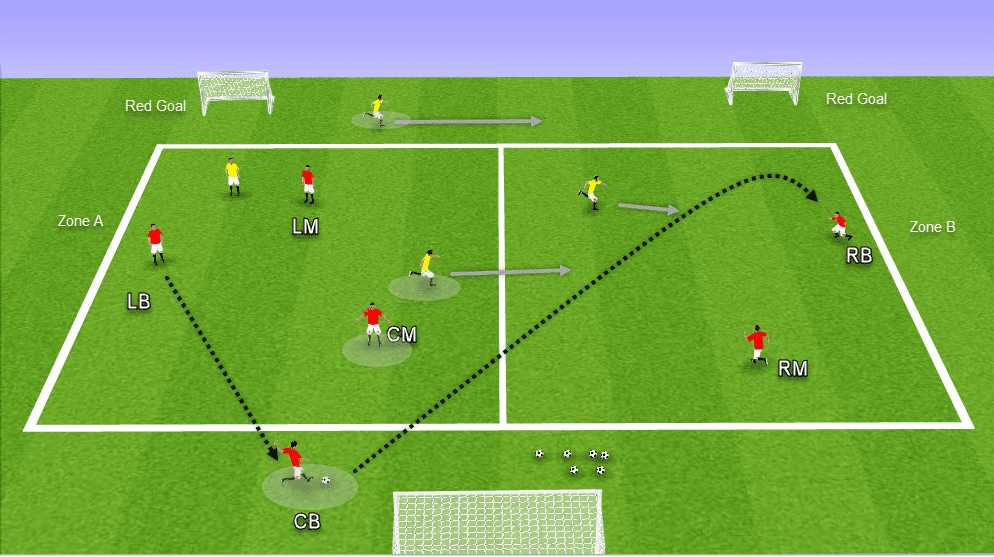
Organisation:
- 45 x 45m area
- Reds start the play with ‘CB’ who can play into either square
- The objective is for the reds to score in either small goal from the adjacent zone
- The condition is that the reds have only ‘7-seconds’ to score from either zone.
- If they go past eight seconds, they have to switch the play to score
- Reds do not have to switch on eight seconds; it just means they can no longer score in that zone until the ball leaves and re-enters the zone.
- Increase or reduce time restriction to get success.
- Red and yellow ‘CB’ can move horizontally but cannot enter either zone.
- Only the red and yellow ‘CM’ can cross into both zones; every other player must remain in their zone.
- If and when yellows win possession, they can score in the big goal at the earliest opportunity.
Coaching:
- Minimise stoppages
- Keep tempo high
- Promote good passing qualities, communication and movement
- CM & CB must have correct body shape to open play and attack the weak side
- Reds to try stretch yellows horizontally to cause imbalance and exploit the weak side.
- Promote overlaps, underlaps and good rotations
- Promote the use of different passing types, such as lofted or chip pass for distance over immediate pressure
- Players must become aware of time restrictions, as in-game scenarios, the longer the play develops on one side of the field, the less likely we are to penetrate or score from that position.
- Reds must try switch play at the highest point and not from Cm when possible to reduce the yellows time to shift across and get organised.
Practice #3: Progression
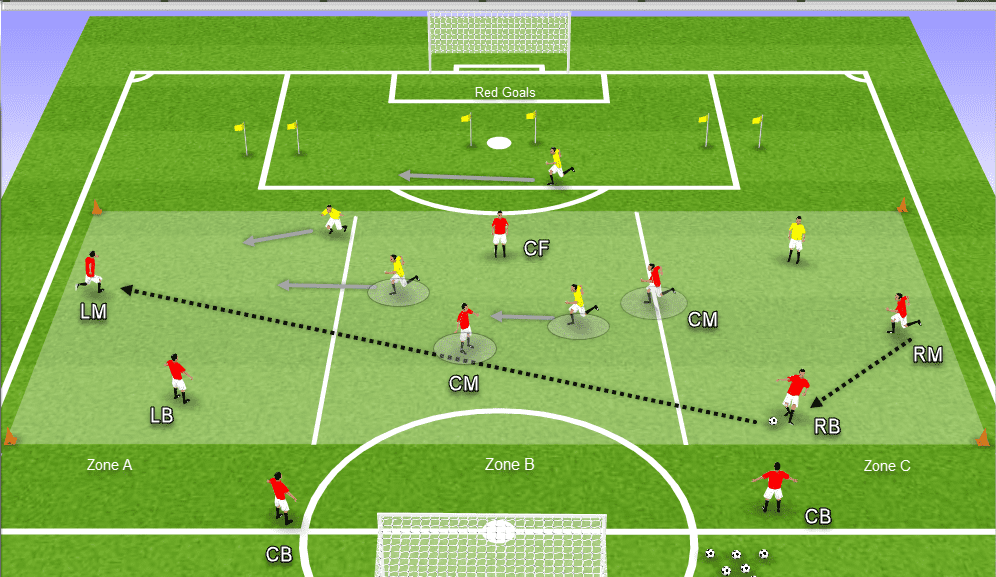
Organisation:
- Three zones, approx. 60 x 30m area
- Reds wide players always remain in their respective zones while the CF stays in the central zone.
- The two Red CM’s can move across all three zones to create overloads and support.
- The condition is that the reds have only ‘7-seconds’ to score from either zone.
- The two Red CB’s can move horizontally to support but not enter any zone.
- Reds looking to score in any from the corresponding zone, however, to score in the central zone it must be a one-touch finish
- Yellows must have one wide player in each area while the two CM’s can move across all three zones.
- If and when yellows in possession, they can score in the big goal at their earliest opportunity.
Coaching:
- Minimise stoppages
- Keep tempo high
- Promote good passing qualities, communication and movement
- CM & CB must have correct body shape to open play and attack the weak side
- Reds to try stretch yellows horizontally to cause imbalance and exploit the weak side.
- Promote overlaps, underlaps and good rotations
- Promote the use of different passing types, such as lofted or chip pass for distance over immediate pressure
- Players must become aware of time restrictions, as in-game scenarios, the longer the play develops on one side of the field, the less likely we are to penetrate or score from that position.
- Reds must try switch play at the highest point and from CM when possible to reduce the yellows time to shift across and get organised.
Practice #4: Conditioned phase of play
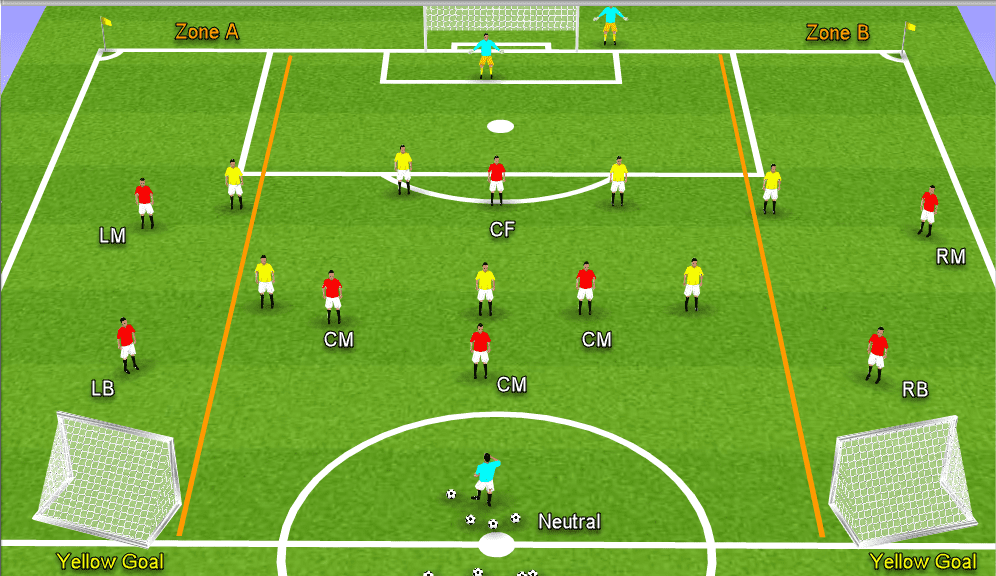
Organisation:
- Two teams and one neutral player on a half pitch
- Play starts and restarts with Reds to score in the primary goal.
- The Reds play a neutral + 2-3-3 shape to honour the 4-3-3 formation
- The Yellows play as GK-4-3 + neutral
- *You can tweak to honour your preferred formation
- In order to score the Reds must first play into both Zone’ A’ and ‘B’ when play starts and when possession is won back.
- This is to promote awareness along with creating and exploiting opponents weak side.
- If and when Yellows in possession, they can score in either goal at the half-way line at their earliest opportunity.
- Depending on your philosophy and style of play, feel free to tweak the counter-attacking condition for the Yellow team.
Coaching:
- Minimise stoppages
- Keep tempo high
- Promote good passing qualities, communication and movement
- CM & CB must have correct body shape to open play and attack the weak side
- Reds to try stretch yellows horizontally to cause imbalance and exploit the weak side.
- Promote overlaps, underlaps and good rotations
- Promote the use of different passing types, such as lofted or chip pass for distance over immediate pressure
- Reds must try switch play at the highest point and from CM when possible to reduce the yellows time to shift across and get organised.
- Reinforce the principal aims of the session and why it is beneficial to play this way over urgency on one side of the field.
Getting success
As always, make sure good passing qualities and sound principles of play are present before having expectations of successful implementation come matchday. This session and its conditions can be tweaked to offer more variety of challenge and excitement for the players.
Consider also the points raised above about promoting more freedom for both full-backs to attack and be present together in the final third. Yes, there are risks if not prepared for; however, there are also some more significant risks in overcaution.
I hope you enjoyed and find the same success I have when you get to implement these practices.
If you have any questions or you would like to discover more on this topic, feel free to write to me on twitter @eaytactics, and I will happily share more here on Total Football Analysis.





Comments